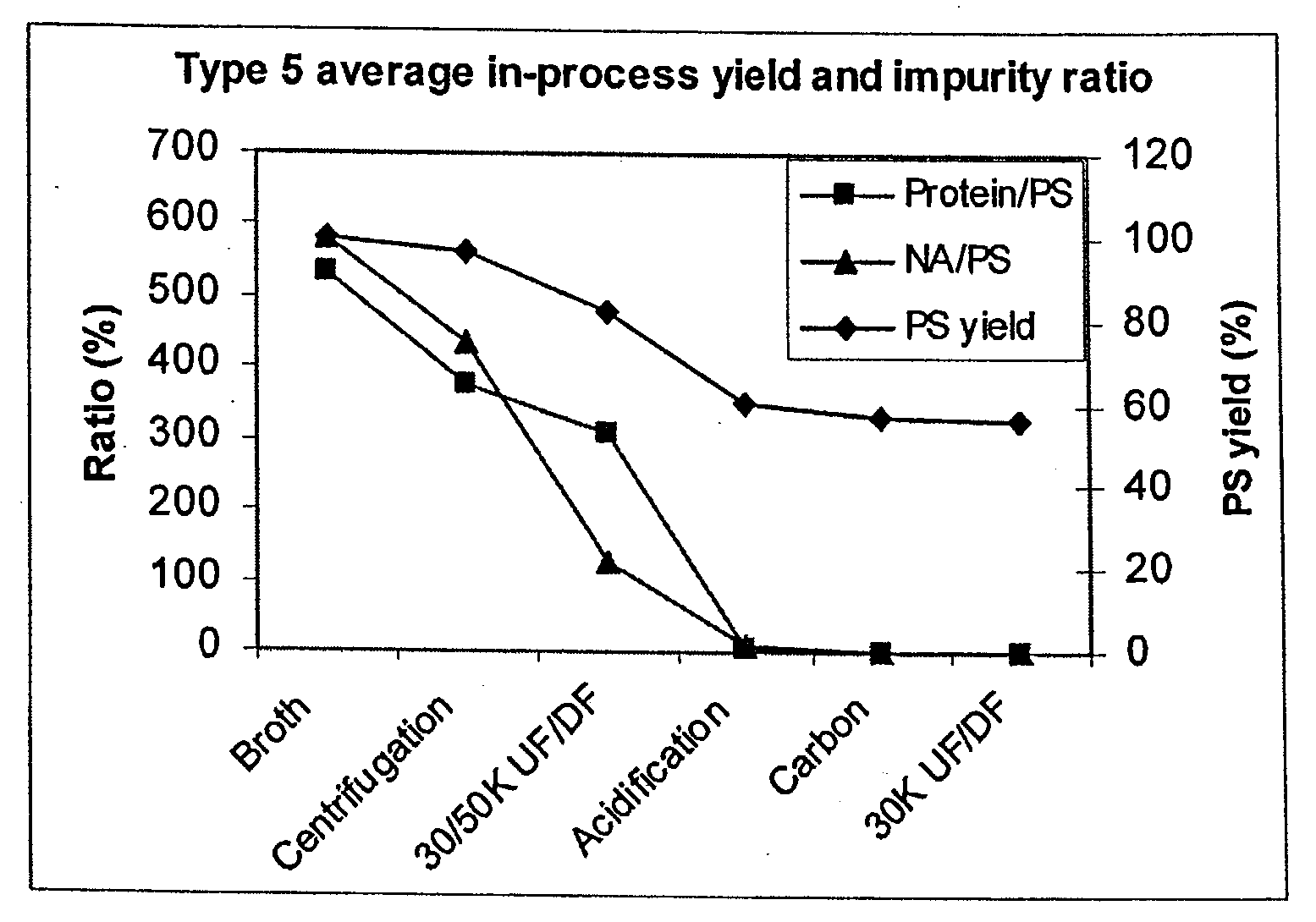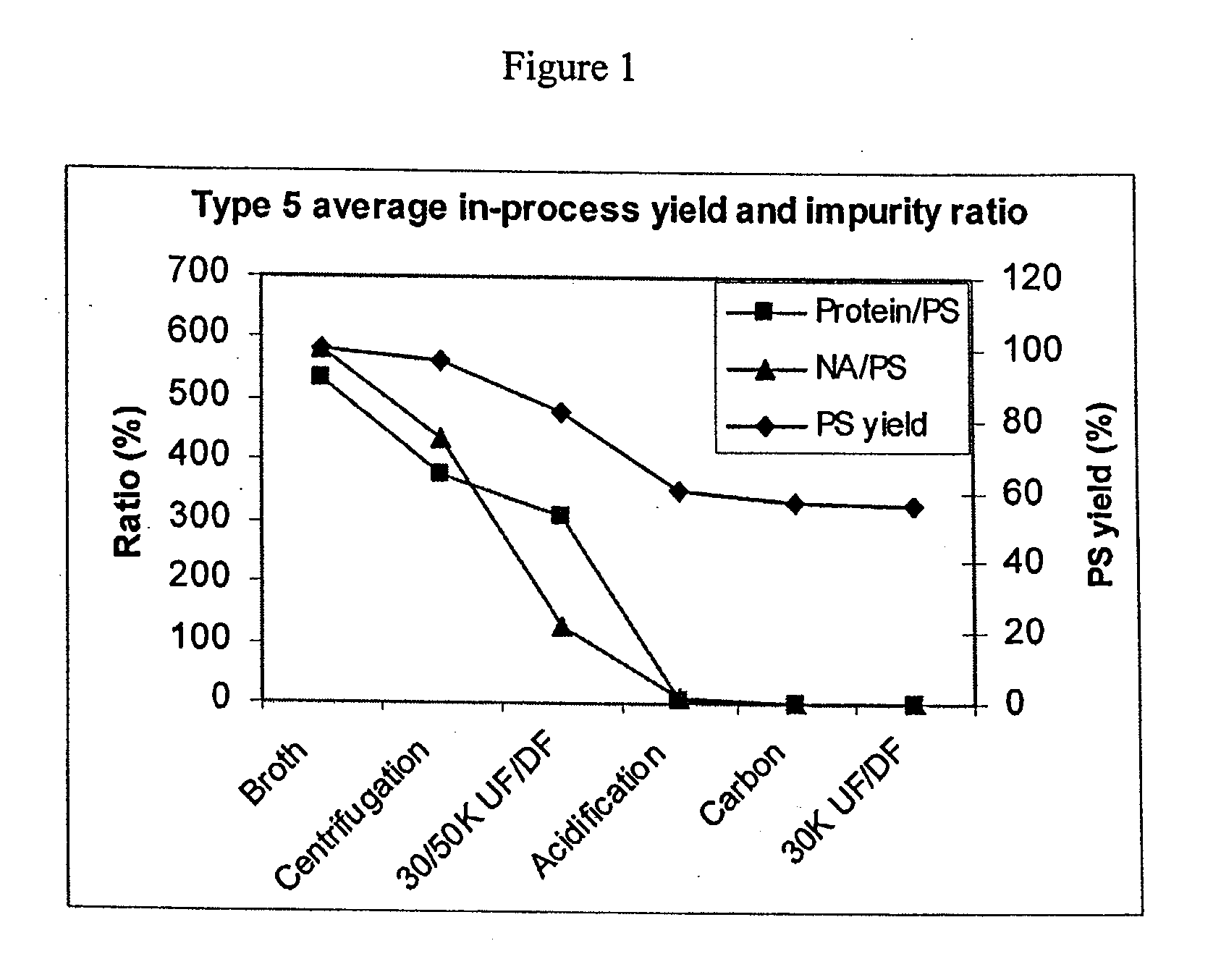Shortened purification process for the production of capsular streptococcus pneumoniae polysaccharides
a technology of capsular streptococcus pneumoniae and purification process, which is applied in the direction of antibacterial agents, immunological disorders, antibody medical ingredients, etc., can solve the problems of complex nutritional requirements, high labor intensity and technologically demanding operations, and the current purification process requires sixteen steps, so as to increase the concentration of polysaccharides
- Summary
- Abstract
- Description
- Claims
- Application Information
AI Technical Summary
Benefits of technology
Problems solved by technology
Method used
Image
Examples
example 1
Shortened Purification Process for S. pneumoniae Polysaccharide Serotypes 1, 4, 5, 6A, 6B, 7F, 14 and 19A
[0098]S. pneumoniae fermentation broths lysed with deoxycholate sodium (DOC) were obtained either within two days following their harvest or stored in 4° C. and processed within the following week. As described below, the present purification process included the following changes compared to the existing purification process: 1) the acidification step was moved from the beginning to after the first ultrafiltration / diafiltration (UF / DF) step, and the pH was adjusted to 3.5 instead of 5; 2) the diafiltration buffer was changed from 0.025 M phosphate to de-ionized (DI) water; 3) carbon adsorption was changed to 2 CUNO R32SP carbon disks (CUNO Inc., Wayne, N.J.) using wood-based phosphoric acid-activated carbon, and the adsorption time was extended from 4 to 12 turnovers (each turnover was 22 minutes); and 4) pH was adjusted to 7.4 during the last 30K diafiltration step when diafilt...
example 2
Comparison of Different Serotypes (Serotypes 1, 4, 5, 6A, 6B, 7F, 9V, 14, 18C, 19A, and 19F)
[0144]To compare purification of the different serotypes using the shortened purification process of the present invention, PS removal for all the serotypes described in Example 1 plus serotypes 9V, 18C, and 19F were plotted in one graph in FIG. 10. Most of the serotypes followed a similar trend with PS loss at each of the purification steps. There was an increase of PS yield for type 6B at the first centrifugation step and type 14 at the acidification step. PS percentage loss varied from serotype to serotype. Type 5 seemed to lose most PS at the acidification step and type 4 at the activated carbon adsorption step.
[0145]Protein / PS ratios for each purification step for each of the serotypes are shown in FIG. 11. The figure shows that there was a difference in initial protein / PS ratios for different serotypes, with types 1, 4, 5, 9V, 19F, and 18C having the highest initial protein / PS ratios. E...
example 3
Acidification and Activated Carbon Adsorption Step Efficiency Analysis (Serotypes 1, 4, 5, 6A, 6B, 7F, 9V, 14, 18C, 19A, and 19F)
[0147]For purification of PnC polysaccharides, the most significant and difficult impurity to remove is proteins. To better understand the impurity removal efficiency of the shortened process, two of the major purification steps, acidification and activated carbon adsorption, were analyzed for protein removal. For the acidification step, the difference in protein concentration (SDS-PAGE) before and after acidification was plotted against the initial protein concentration before acidification for serotypes 1, 4, 5, 6A, 6B, 7F, 9V, 14, 18C, 19A, and 19F using the shortened purification process of the invention (FIG. 13).
[0148]Due to relatively small changes in solution volume before and after the acidification step, the protein concentration difference divided by the initial protein concentration reflected the protein removal rate by the acidification step. ...
PUM
| Property | Measurement | Unit |
|---|---|---|
| Temperature | aaaaa | aaaaa |
| Fraction | aaaaa | aaaaa |
| Fraction | aaaaa | aaaaa |
Abstract
Description
Claims
Application Information
 Login to View More
Login to View More - R&D
- Intellectual Property
- Life Sciences
- Materials
- Tech Scout
- Unparalleled Data Quality
- Higher Quality Content
- 60% Fewer Hallucinations
Browse by: Latest US Patents, China's latest patents, Technical Efficacy Thesaurus, Application Domain, Technology Topic, Popular Technical Reports.
© 2025 PatSnap. All rights reserved.Legal|Privacy policy|Modern Slavery Act Transparency Statement|Sitemap|About US| Contact US: help@patsnap.com



